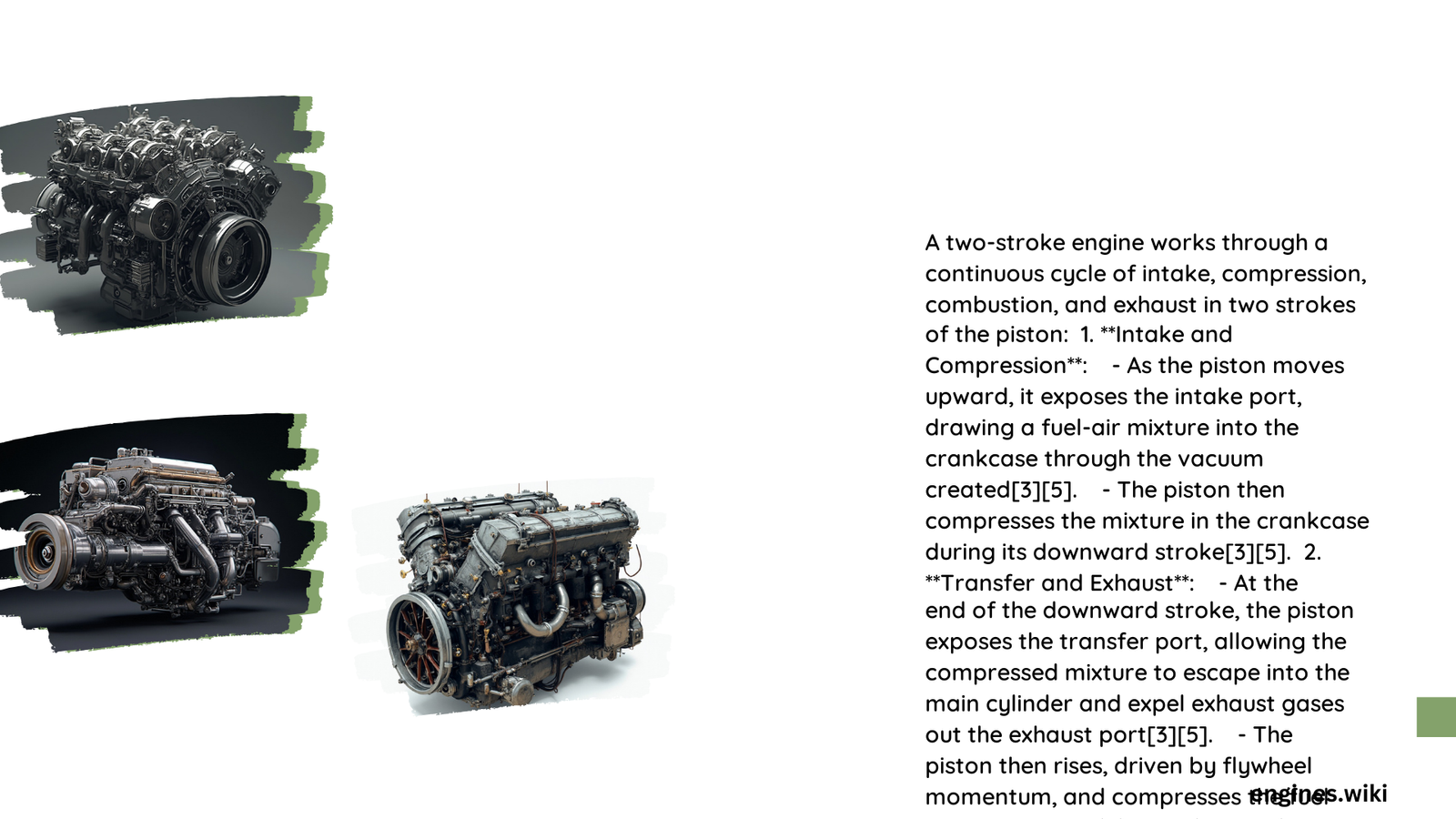A two-stroke engine completes its cycle in just two piston strokes, making it more compact and powerful than four-stroke engines. The animation of a two-stroke engine reveals its unique operation, where intake, compression, power, and exhaust occur simultaneously. This efficient design allows for a higher power-to-weight ratio, making two-stroke engines popular in small vehicles and handheld tools.
What Are the Key Components of a Two-Stroke Engine?
A two-stroke engine consists of several crucial components that work together to generate power:
- Cylinder
- Piston
- Connecting rod
- Crankshaft
- Spark plug
- Intake port
- Transfer ports
- Exhaust port
Each of these components plays a vital role in the engine’s operation, as demonstrated in animations of the two-stroke cycle.
How Does the Intake Phase Work in a Two-Stroke Engine?

The intake phase in a two-stroke engine is unique and occurs simultaneously with other processes:
- As the piston moves upward, it creates a vacuum in the crankcase.
- This vacuum draws the fuel-air mixture into the crankcase through the intake port.
- The upward motion of the piston compresses the mixture in the crankcase.
Animations clearly show this process, often using color-coded flows to represent the movement of the fuel-air mixture.
What Happens During the Compression Phase?
The compression phase is critical for the engine’s power output:
- As the piston reaches the top of its stroke, it begins to move downward.
- This downward movement uncovers the transfer ports.
- The compressed fuel-air mixture from the crankcase enters the combustion chamber through these ports.
- The piston’s continued downward motion compresses this mixture in the combustion chamber.
Animations typically illustrate this phase by showing the flow of the mixture from the crankcase to the combustion chamber.
How Does the Power Stroke Generate Energy?
The power stroke is where the engine converts chemical energy into mechanical energy:
- Just before the piston reaches the top of its stroke, the spark plug ignites the compressed fuel-air mixture.
- This ignition causes a small explosion, generating high pressure.
- The pressure pushes the piston downward with great force.
- This downward motion drives the crankshaft, producing power.
Animations often depict this phase with a visual representation of the spark and the resulting explosion.
What Occurs During the Exhaust Phase?
The exhaust phase is crucial for clearing the combustion chamber:
- As the piston moves downward, it uncovers the exhaust port.
- The high-pressure exhaust gases escape through this port.
- Simultaneously, the fresh fuel-air mixture entering through the transfer ports helps push out the remaining exhaust gases.
This process is often shown in animations with arrows or colored flows indicating the direction of the exhaust gases.
How Do All These Phases Work Together in the Two-Stroke Cycle?
The beauty of the two-stroke engine lies in its ability to perform multiple functions simultaneously:
| Piston Position | Crankcase | Combustion Chamber |
|---|---|---|
| Moving Up | Intake | Compression/Power |
| Moving Down | Compression | Exhaust/Transfer |
This table illustrates how different processes occur concurrently in different parts of the engine, a concept that animations effectively demonstrate.
What Are the Advantages of Using Animations to Explain Two-Stroke Engines?
Animations offer several benefits when explaining the complex workings of two-stroke engines:
- Visual clarity: They provide a clear visual representation of internal processes that are otherwise hidden.
- Dynamic representation: Animations show the continuous motion and interaction of engine components.
- Simplified complexity: Complex concepts are broken down into easily understandable visual sequences.
- Enhanced learning: Visual learners can grasp the concepts more easily through animated demonstrations.
How Do Animations Address the Challenges of Explaining Two-Stroke Engines?
Explaining two-stroke engines can be challenging due to their complexity, but animations help overcome these challenges:
- Simultaneous processes: Animations can show multiple processes occurring at the same time, which is difficult to convey through static images or text alone.
- Rapid cycle: The quick cycle of a two-stroke engine is easier to understand when slowed down in an animation.
- Internal mechanics: Animations can ‘see through’ the engine, showing internal workings that are normally hidden.
- Cause and effect: The relationship between different actions in the engine cycle is clearly demonstrated in animations.
What Are Some Key Features to Look for in Two-Stroke Engine Animations?
When studying two-stroke engine animations, look for these important features:
- Color-coding: Different colors for fuel-air mixture, exhaust gases, and other components.
- Directional indicators: Arrows showing the flow of gases and movement of parts.
- Timing indicators: Visual cues that show when specific events occur in the cycle.
- Cross-sectional views: Cut-away views that reveal the internal workings of the engine.
- Slow-motion sequences: Detailed breakdowns of rapid processes.
These features enhance the educational value of the animations and provide a more comprehensive understanding of how two-stroke engines work.
In conclusion, animations play a crucial role in explaining the complex workings of two-stroke engines. They provide a dynamic, visual representation of the engine’s cycle, making it easier to understand the simultaneous processes that occur within these compact powerhouses. By utilizing color, motion, and detailed visuals, animations break down the intricate mechanics of two-stroke engines into digestible, educational content that appeals to both novices and experts alike.
References:
1. Two-stroke engine – How it works (Animation)
2. 2 Stroke Engine Animation And Diagrams
3. Two stroke – Animated Engines
